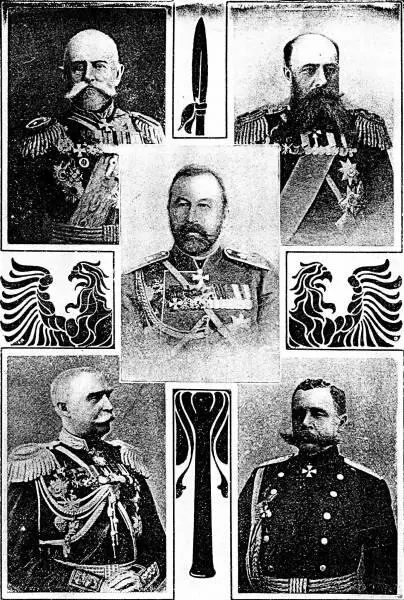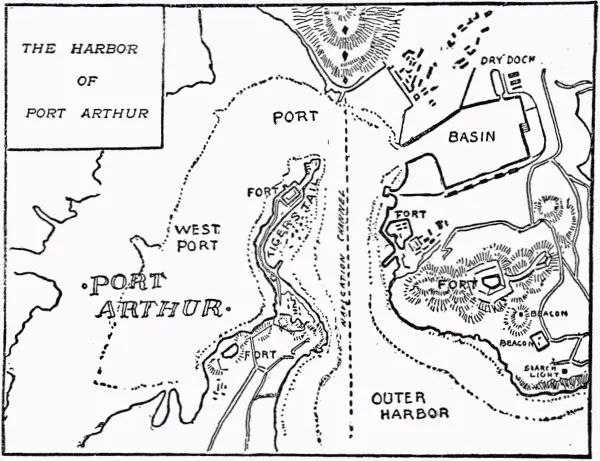1 ...7 8 9 11 12 13 ...20 Slowly but steadily the two ships held on their course towards the Polynesian Archipelago, where lay in wait their powerful foe. The Varyag had reached Round Island, when at a distance of nearly two miles the Japanese flagship opened fire with one of her big guns. The aim of the gunners was true. Right amidships burst the great missile, doing terrible execution, and shell after shell followed with relentless rapidity. The Varyag , wheeling around in a small circle, responded dauntlessly with her 6-inch guns, but with little or no effect upon the battleship, and now Admiral Uriu's cruisers joined in the cannonade. Within half an hour of this fearful raking fire her bridge was shot away and her sides were gaping with holes, but she kept afloat and still withstood the onslaught, endeavoring heroically but in vain to find an opening by which to break through and escape out to sea. At last, after an hour's terrible pounding, she was compelled reluctantly to give up the attempt as hopeless, and, taking refuge among the islands, with difficulty crept back into Chemulpo harbor, disabled beyond repair and with her decks reduced to veritable shambles. Her desperate struggle had not left the enemy utterly scathless, for there seems no doubt that one of the Japanese cruisers received a good deal of damage.
In the meanwhile the little Korietz , with extraordinary bravery, but with absolutely pathetic ineffectiveness, had been attempting to imitate the manœuvres of her consort and to do some injury to the big ships of the enemy. As well might a warrior with a popgun try to engage a battery of field artillery. It was magnificent, it certainly was not war. The range was hopelessly beyond her powers, and perhaps it was the bitterest drop in the cup of her commander and crew that the Japanese soon ceased to pay her any attention at all, concentrating all their efforts upon the more dangerous Varyag . When that vessel retreated at length into harbor, the Korietz followed her unharmed but undisgraced.
The wounded of the Varyag , numbering 4 officers and 214 men, were removed in boats to the British, Italian and French warships. The dead were left on board, for it was decided to scuttle the ship. At the same time arrangements were made to blow up the Korietz . Just as the Japanese fleet again appeared in sight the latter vessel blew up, and the shattered hull, after one great burst of flame and smoke, sank beneath the waters. The Varyag refused to sink so easily, and the Russian sailors therefore again boarded her to set her on fire. After a little more than an hour she had burned down to the water's edge and, heeling over, disappeared. The Sungari was the next to meet its fate, the Russians setting fire to it also to prevent its falling into the hands of the enemy.
The Japanese fleet then steamed out to sea once more, having left behind it no further obstacle to the landing of troops on the west coast of Korea.
Thus within forty-eight hours of the rupture of diplomatic relations, the first decisive action in the struggle for sea-supremacy had been fought, and the result left to the enterprising and intrepid Navy of Japan not only the immense moral value of a victory well contrived and unerringly accomplished, but the solid material advantage of a superiority in fighting strength which was incontestable.

| GENERAL LINEVITCH. |
|
GENERAL GRIPENBERG. |
|
GENERAL KUROPATKIN. |
|
| GENERAL KAULBARS. |
|
GENERAL RENNENKAMPFF. |
RUSSIAN GENERALS.
Table of Contents
If the Russians at Port Arthur imagined that an enemy so resourceful as Admiral Togo had shown himself to be would rest quietly upon his oars after the conspicuous successes of the 8th and 9th of February, they were greatly mistaken. The first course of action for the victor in such a case is to keep on striking and to give the harassed foe no rest—in the striking words of Captain Mahan, to "benumb the victim." This was precisely the plan of campaign adopted by the Japanese, who continued to show the same remarkable skill and coolness of calculation, and the same dash and daring in execution as had characterized their naval operations from the first. On the other hand, the disorganization of the Russian fleet, and of the defending force at Port Arthur generally, showed itself more markedly than ever, and the incapacity of the Czar's commanders conspired to aid the enterprise of the Japanese.
Before entering, however, upon a narrative of the attacks upon Port Arthur which followed in swift succession upon the great battle of the 9th, it may be well to give some description of that famous stronghold. The inner harbor is oval in shape, and two miles long from east to west and a mile in breadth from north to south. The shores are protected by hills, which the Russians had assiduously fortified since they obtained occupation of the place. Entrance is afforded from the south by a narrow channel, so narrow indeed that while it has the advantage of being easily held against an enemy, it has the counteracting disadvantage of being somewhat difficult of navigation for the ships of the defending fleet. The mouth of this channel is protected on the southwest by two dangerous reefs, which would prove a snare to an unwary foe; while on the eastern shore there stands the hill of Kwang-chin-shan, 250 feet above the sea level, upon which frown the guns of several powerful batteries. Upon the lower slopes the Russians had established two batteries of Canet quick-firing 5.5in. and 7.5mm. guns, with a torpedo and searchlight station. The entrance channel is flanked along the northwest by a narrow strip of land which goes by the expressive name of the "Tiger's Tail," and this strip was fortified with battery of 7 Canet 5.5in. quick-firing guns. The distance from the Pinnacle Rock, one of the reefs above mentioned as situated at the western corner of the entrance passage, to the opposite shore, is nearly 350 yards. In its course the channel narrows, till at one point it is only 500 feet in width, but it widens out again at the northern end. At the northeastern end lies the basin, or East Port. There is accommodation here for about a dozen large men-of-war, and on the north side stands the one dry dock for repairing large vessels of which Port Arthur can boast. On the other side of the channel, which at this point is 430 yards in width, lies the mouth of the harbor proper, facing the southeast. To enter it, ships have to round the Tiger's Tail, not a particularly easy process for men-of-war of the largest size. Nor is the harbor itself yet fitted to receive a great fleet. When the Russians took it over they found that it was too shallow for berthing vessels even of a moderate size; and in spite of the feverish activity of their engineers in the last year or two, the dredging operations have not proceeded far enough to allow of accommodations for more than three battleships, together with minor craft. Hence the Port Arthur squadron has generally been disposed either in the East Port, or basin, or in the open roadstead outside the entrance channel. It was indeed the position of the Russian ships in this latter anchorage that gave the Japanese the opportunity for their fatal torpedo attack on the 8th.

The land defences of Port Arthur were exceptionally strong. A range of forts, of which the Kwang-chin Hill already mentioned was the most important, commanded the harbor entrance; and another range of batteries, with the most powerful and up-to-date garrison ordnance, surmounted the hills which surround the town and protect it on the other side. Another line of forts guards the entrance channel on the west side, the most important being Wei-yuen. It seemed, indeed, undoubted that Port Arthur was impregnable from the sea, though at the beginning of the war European experts were not inclined to dogmatize as to the possibilities of its being stormed from the land side. As for the fleet, if it were lying in the West Harbor or in the East Port under the shadow of Kwan-chin, it would probably be perfectly safe from attack; but, on the other hand, it will be seen that there was a danger that the narrow entrance channel might be blocked up by an enterprising enemy, in which case the Czar's ships, even if they were the finest in the world, would be useless for all the essential purposes of naval warfare. This attempt to "cork up the bottle" was, indeed, nearly carried out by Admiral Togo in the course of the fortnight following the outbreak of war.
Читать дальше














